#north east india trip
Explore tagged Tumblr posts
Text
North East – The Unexplored Family Tour
While you're here, you might get a better understanding of what it's like to live in the foothills of the Himalayas and watch the dawn over some of the highest mountains and deepest valleys in the world. While you're here, you'll be able to witness the sunrise over some of the highest mountains and deepest valleys in the world. You might learn something useful from going through this experience. If you have a strong desire to get away from the hustle and bustle of the city, you should give some serious thought to the possibility of moving to the serene hills instead. This is the best option for people who have this kind of desire. If you are going to be in the area of the country that is found to the northeast of the country, it is highly recommended that you pay a visit to the tea estates that are located in Darjeeling. When you get the opportunity to do so, you should definitely seize the chance to indulge in some traditional momos and Darjeeling tea while you are in this area.
Must See: Tsomgo Lake to see the Red Panda, migratory ducks, and other species of flora and wildlife; Yumthang Valley for its breathtaking panoramic magnificence; Rumtek Monastery for its one-of-a-kind religious art artifacts; Darjeeling for its toy train ride and its real tea flavors.
Please don't hesitate to get in contact with one of our experienced Trip Counselors if you have any questions about the educational and cost-effective Northeast trips we provide.

#north east india tour#north east tour packages#northeast tour#north east trip#north east india tour packages#north east package#north east india trip#north east trip packages#north east travel package#5 days trip to north east india#north east tour package from delhi#north east holiday packages#north east tour packages 15 days#north east family tour packages#north east tour package from kolkata#north east tours and travels#north east tour packages from guwahati#north east trip from delhi#northeast india tour#best north east tour packages#budget trip to north east india#Trip Counselors#trip planner#tour planner#solo trip#tour and travel#best trip#trip and tour
0 notes
Text
Can someone help me to plan a trip to north east india?
Can someone help me to plan a trip to north east india? https://www.quora.com/Can-someone-help-me-to-plan-a-trip-to-north-east-india/answer/Sameer-Mehta-119
#northeastindia #tours #reconholidays #assam #arunachalpradesh #manipur #mizoram #tripura #meghalaya #nagaland #tourpackages
0 notes
Text
What Makes the North East of India a Paradise for Motorcycle Adventures?

The North East of India is a captivating region that offers a paradise for motorcycle adventurers. From its stunning landscapes and diverse terrain to its rich cultural heritage and warm hospitality, there are several factors that make it an ideal destination for a bike trip. Let's explore what makes the North East of India a haven for motorcycle adventures.
First and foremost, the North East boasts breathtaking landscapes that are a delight for riders. From the rolling hills of Meghalaya to the lush tea gardens of Assam, the snow-clad peaks of Arunachal Pradesh, and the winding roads of Sikkim, the region offers a diverse range of scenic beauty that will leave bikers awe-inspired at every turn.
The North East is also known for its diverse and challenging terrain. Riders can experience the thrill of conquering high mountain passes, navigating through dense forests, and riding alongside gushing rivers. The twisting and winding roads offer a thrilling experience and make for unforgettable journeys.
Moreover, the cultural diversity of the North East adds an extra layer of charm to motorcycle adventures. The region is home to numerous indigenous tribes, each with its distinct customs, traditions, and cuisines. Interacting with the locals and immersing oneself in their rich cultural heritage is an enriching experience that adds depth to the journey.
Safety is another factor that makes the North East a preferred destination for motorcycle adventures. The region is known for its friendly and welcoming people who prioritize the well-being of visitors. Additionally, the presence of experienced tour operators and well-maintained roads ensures a safe and enjoyable ride.
Lastly, the North East still remains relatively unexplored and untouched by mass tourism, allowing riders to experience a sense of authenticity and tranquility. The absence of large crowds adds to the charm and allure of the region, making it a haven for those seeking solitude and a genuine connection with nature.
In conclusion, the North East of India offers a perfect blend of stunning landscapes, challenging terrains, cultural richness, and safety for motorcycle adventurers. Embarking on a bike trip to the North East is an opportunity to witness the unspoiled beauty of the region, forge unforgettable memories, and discover the hidden gems that make this part of India a paradise for motorcycle adventures.
0 notes
Text
#Singapore Tours Package Including Sentosa Island Tour#Sri Lanka Honeymoon Tour Packages From India#Trip to Uttarakhand#Himachal Honeymoon Tour Packages#North East Tour Packages#Honeymoon Packages of Malaysia#Family Trip to north east#Vaadhoo Island Resort Maldives Tour Packages#Best Honeymoon Packages for Mauritius#Kerala Tour Packages#Goa Tour Packages From Udaipur Rajasthan#Best Sri Lanka Tour Packages#Travel Agency for Thailand Seaside Tours#Goa Tour Packages#Gujarat Tour Packages#Book Rajasthan Tour Packages
0 notes
Text
Notes on a South Asian Tropical Cyrodiil (and more!)
So, many TES fans know that before Oblivion, Cyrodiil was supposed to be tropical. The most striking phrase to describe it, "most is endelss jungle", says it all. The quick and snarky explanation is that Todd Howard watched LOTR, was "inspired" by it, and that's why everything in Oblivion looks sort of like a Rennaisance Fair. In any case, I think it was a huge missed opportunity, especially in a world where most popular fantasy is European inspired, to have replaced what could have been very cool tropical enviroments with what is frankly a lame "Talos used his magic" lore retcon. You can read the 1st edition of the Pocket Guide to the Empire to see what we missed.
But it's not only Cyrodiil which we missed this way… Tamriel just makes more sense as a tropical continent. While the size and the exact location of the continent is discussed by nerdier nerds than me, I think it does make sense like this, and not only that, we have a very interesting world parallel to compare it to: India. From a tropical rainy south to the cold mountains of Skyrim, Tamriel is surprisingly similar to the Indian subcontinent, and many of its geographical quirks can be explained if, instead of assuming a temperate Cyrodiil, we go all out with that concept. This is going to be a long post, you have been warned.
So with that in mind, I'll try to make a not-so brief tour (with some evocative pictures along the way) of a rebuilt tropical Tamriel, following the rains of the moonson:
The position of Tamriel, in this case, would be roughly where the Indian subcontinent is located in real life, that is again, tropical, stretching the Tropic of Cancer (is there a name for the tropics of Nirn? Interesting to think about) Here, we see our numbers pan out well: Tamriel is mentioned to be between 4000 and 3000km across east to west and 2000 and 3000km south to north. VERY, VERY roughly, there is 4000km between Pakistan and Myanmar, and 3000km from Sri Lanka to the northern tip of Tibet. Plot that on a map, and you already can see some coincidences. Now, this is a rather average continent, not Pangea sized like some imagine Tamriel to be. This does help explain why, for example, the interior of Cyrodiil is rainy and good for agriculture instead of a desert. But it also means that it's very likely that Tamriel is ruled by monsoons. Monsoons are complex, but they basically form when there are plenty of warm places for water to evaporate (the South Indian ocean), and mountains that block cool winds from the opposite direction (the Himalayas). We have a very similar situation here, with a mountainous Skyrim on the north of a tropical Cyrodiil facing an equatorial southern ocean. So, what happens are monsoons, perhaps not as strong as IRL India, but carrying rains very deep into the continent. This would feed the rivers and the rich agricultural areas of Cyrodiil, and would have some other consequences.
So let's imagine our trip South to North. In the South, in Black Marsh, Blackwood and Lleyawiin, and Pellentine (southern Elsweyr) we would find, much like in the original lore, humid tropical climates, jungle, wetlands, and my favorite, mangrooves. I would expect mangrooves to stretch in this whole area, across rivers. In fact, one of the reasons why Black Marsh could be so hard to explore and control by the Empires at Cyrodiil would be the presence of thick mangrooves all over its coast. This is the region of Cyrodiil that would most resemble "endless jungle".
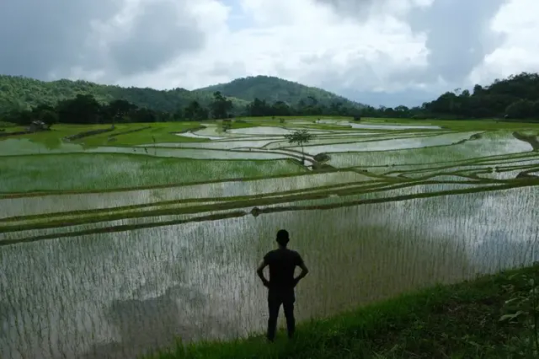
(Rice fields in India, what I imagine most of this Tropical Cyrodiil would look like)
However, as any lore person knows, Anequina, northern Elsweyr, is arid desert. Does this mean a contradiction? Far from it, we have a similar example in IRL India: the Deccan Plateau, which has a semi-arid to arid climate. This can be easily explained by higher elevations up to a small mountain chain separating it from Cyrodiil to the north, and the fact that little rain would reach behind this "Anequina Plateau" would make the region of Kvatch and Anvil more dry much like in canon, in this case, more scrublike. This highland desert would not be as harsh as Elsweyr is usually concieved, maybe, but its driest regions might justify places such as Dune. (On that matter, it always bothered me to read about the "cities" of southern Elsweyr and there being only two or three there. If I had to redesign it, I would move some from the north to the south).
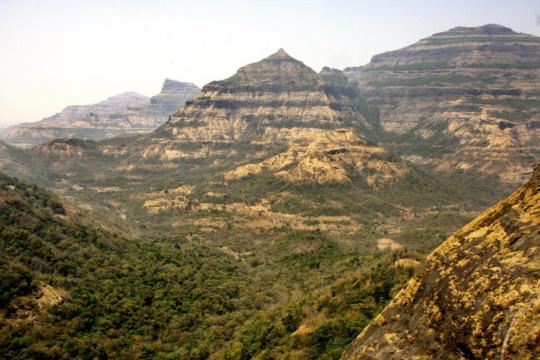
(the Deccan Plateau in India, it gets greener or drier according to the monsoon)
Keeping on our tour of Tamriel, the Topal Bay and the very rainy Black Marsh funnels the rainy monsoon from the south towards central Cyrodiil. Here we find the endless jungle of the Nibenay Valley. But unlike the rainforests of Elsweyr and Black Marsh, these dense forests and rich river plains are mediated by the monsoon winds, with dry seasons alternating with copious rain. This has huge effects on agriculture and culture in general, as agriculture is defined by the rythms of the rain. Keeping with our South Asian theme and the 1st edition of the Guide to the Empire, Cyrodiil would have huge extensions of rice paddies, as well as terrace farming and much hardier crops in the highlands, instead of the… well, almost absent agriculture we saw in Oblivion. The food, clothing, architecture and overall culture of Cyrodiil would be very different with this. The original Pocket Guide said some of its main exports besides rice and fruit are moon sugar and silk. Moon sugar in Cyrodiil, can you believe it?
Another thing I imagine Cyrodiil would be famous for would be fish and seafood, well, river food. Rice plantations can host fishes and crustaceans to get some extra protein, and well, what about mudcrabs? Hell, as preparing muddy soil is vital for rice cultivation, no wonder mudcrabs are considered a nuisance. Imagining critters in gameplay in such an enviroment also makes my mind roam. Tigers, elephants, rhinoceros, and this is not even getting into the more mythical creatures you could find, instead of endless wolves… Rice cultivation is also more labor intensive than other crops, and it also has a deep impact on the terrain, "terraforming" so to say, huge expanses into paddies and terrace farms. This level of cultivation also requires an established infraestructure of irrigation. While this does not necessarily means a centralized goverment, as farmers can build it and maintain it by themselves, the rise of an empire, i.e., the Empire, will also increase the complexity of these systems, adding canals, dams, reservoirs and more ambitious projects, like we see in India and China. I am sure some people more knowledgeable about those cultures can comment more.
While this Cyrodiil is a tropical/subtropical region covered in "endless jungle", some parts might indeed resemble the rolling hills and grasslands you see in Oblivion. Deforesting jungle for pasture is something very common around the world (some have joked this mass deforestation was later in canon explained as a gift from Talos lol) and you can see the results, like in tropical Australia and my closer Mata Atlantica, do superficially resemble temperate pastures in say, Europe. Until you notice the palm trees, of course. But yes, I can see the Nords being a mostly herding people (more on that below) bringing their sheep and cows to the tropical lowlands and, well, deforesting to make space for them.
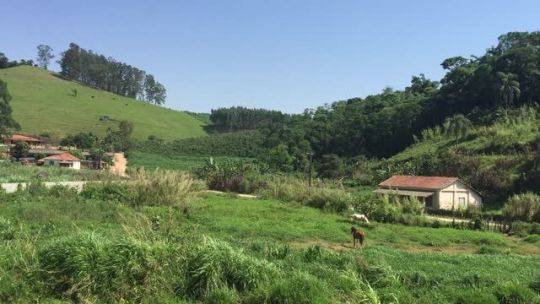
(ranches in Sao Paulo state, Brazil, notice the palm trees)
Imperial City just so happens to be built in an island in the middle of several river crossings, in what seems to be a swampland. The first thing that came to mind when I read that was Tenochtitlán. The districts of Imperial City would have been built over the centuries on artificial islands on a shallow lake, using plentiful mud and organic matter to make fertile chinampas. I believe this would make for a striking sight. Instead of just a city in the middle of a empty island, you would see the White-Gold tower and the rest of Imperial City rising from Lake Rumare, surrounded by rich farmland and its districts joined by walkways. (much like the old descriptions, actually, could you believe I wrote that without reading them?)

(Reconstruction of Tenochtitlán... and I just noticed, it's surrounded by (volcanic) mountains too, much like Imperial City)
Much like the Pantanal is one of the sources to the Paraguay River (which merges with the Paraná and then the Río de la Plata) IRL, here, the swamps of central Cyrodiil would be the source of the Niben. This does raise an interesting question, where is the source of the Niben? Is it Lake Rumare? No, I believe it would be several smaller rivers all the way from Bruma and even Skyrim. These small, violent mountain rivers eventually flow into the Rumare wetlands and only THEN in the placid great Niben. You DON'T want to be caught in one of the mountain valleys in rainy season. This does raise the question; won't the developments upriver, like Imperial City itself and the surrounding farmland, affect the course of the river downwards? There's plenty of water from the rain, but a more developed Cyrodiil might indeed have to grapple with this, supposing, for example, they manage to dam the river.
Looking west, we got the Colovian region, said to be composed of drier highlands and cliffs in the early Pocket Guide. Probably cut from the rain because of the Anequina Plateau, this is indeed more arid or "mediterranean", though I actually see it as more Australian. Maybe some of the drier parts near Hammerfell, resembling Argentine Cuyo and the northwest, would be a distant cry from the wetlands, having thorny dry forests and dry valleys, where yes, you could plant wine. The wetter cloud forests (much like the Yungas in South America, the place where the rain reaches last) could maybe be the home of the last pre-Imperial cultures of Cyrodiil. Fascinating places.
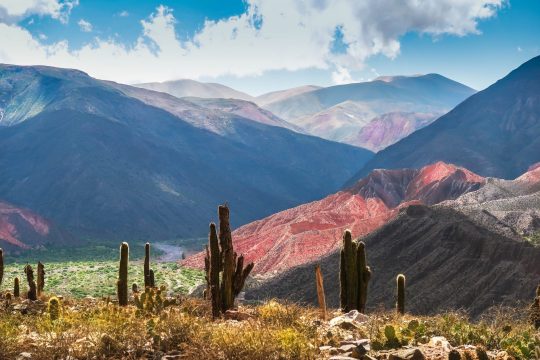
(Jujuy, Argentina. Just *near* are the Yungas cloud forests, where the last rains from the Atlantic meet the Andes, making for some AMAZING places)
Given that I mentioned enviroments near to/on the Andes IRL, let's talk about potatoes. Potatoes are unique crops, because they are the only ones who offer such calories and also be planted in cold enviroments like Europe. Or Skyrim. The discovery and spread of potatoes would cause demographic shifts on people living in cold areas. And they also originated in a unique enivorment IRL: the Andes, actually with possible hybridization from the Magallenic foresWHAT I MEAN, is that potatoes are very important and have been domesticated in very specific conditions. The Wroghtgarian Mountains would seem like a perfect equivalent of the Andes at the first glance, but they would be very different. The Andes, located between the Pacific Ocean and the greater Amazonian region, are very, very unique enviroments. These mountains, however, are in between inner seas. Something like the Atlas or the Alps? In any case, if there is some people who would appreciate hardy tubers that can grow in mountainous places, they are for sure the Orcs, or perhaps the Reachmen. Maybe an hybridization even between them?
This returns me back to Bruma and Skyrim. Some people (who make those excellent Oblivion mods) imagine Bruma with a Tibetan flavor. Personally, I imagine it more like Pakistan or Afghanistan, with lots of mesas and plateaus and valleys. It would look dry and rocky with some very fertile valleys by snowmelt, but it would look like a snowy wonderland on winter, indeed, Pakistan and Afghanistan are very snowy. Eventually, of course, ending up in the great barrier of the Jerall mountains and finally, Skyrim.
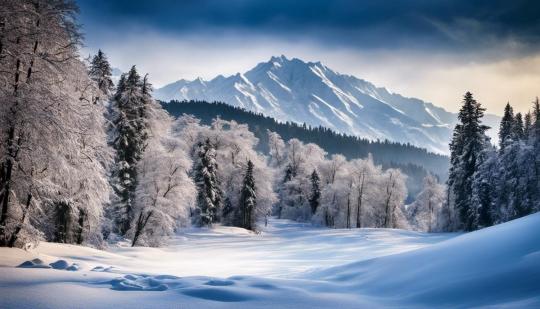
(the Alps? Skyrim? No, this is Kashmir on winter!)
In this scenario, Skyrim would be a quite dry place… or would it? There is no need for the Jeralls to be a straight line of peaks like the Himalayas. They could be a more "broken" series of mountains, like the southern Andes, but in any case, the rain from the south would clash into the higher mountains. Indeed, that is what actually happens in the Himalayas, the foothills of the Himalayas are some of the rainest places IN THE WORLD. These small valleys are something very unique and not very well known part of the world IRL. I can imagine the Skyrim equivalent would be as unique too, hard to navigate and live in. The forests of the Rift and Falkreath would be mazes of windy forests valleys, each with their own unique secrets under a perpetual fog and drizzle. This is a very interesting enviroment to imagine, where again, some of the older cultures of Tamriel could still live.
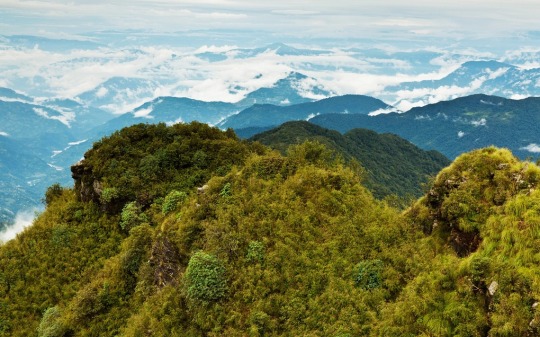
(forests of Bhutan, note how the humid valleys stretch into the distance before the cold Himalayas begin)
However, what does Skyrim look like once you cross the border with Ralof? I imagine some sort of more fertile Tibet, not as high as the Tibetan plateau, allowing for forest and alpine tundra. This is mostly because, while Skyrim is high up, I don't imagine as a plateau, but rather a series of broken mountains like the North American Rockies, which makes sense when you account for all the volcanic activity (there is another super-volcano down in Skyrim but nobody notices). I imagine that Skyrim would be a primarily herding pastoral land before the introduction of hardier crops such as potatoes, and even then. Nord culture would be very interesting reimagined like this; hillforts guarding herds of sheep and cows. It would also create a clash between the very, very agrarian south and the nomadic herding north, with High Rock and Hammerfell a gradient between the two.
But here we enter a problem; if we are operating on a level where Cyrodiil is roughly at the same latitude of India, wouldn't that make Skyrim too far from the poles to allow its tundra like climate, even with elevation? No doubt. Tibet is only as cold as it is because it's the roof of the world and far from any ocean. The northernmost tip Skyrim, like Tibet, would be at the latitude of Turkey, Korea or California, which can get quite cold, but not to the level of what we see on Winterhold or Dawnstar (Solitude sounds familiar, though). What's more, having an ocean up north would only moderate the temperature. Cool currents often don't bring cold per-se, just decrease rainfall. This would end with a very temperate and pleasant Skyrim instead of tundra. Which is on its own, interesting to explore.
Could Nirn be going through an ice age, like it's implied with the dissapearance of Atmora? Possibly, but it would imply revising everything I said before, as ice ages decrease rainfall and mess up with weather patterns all over the world. A colder Nirn would explain a lot, though.
I decide I will stop here, I haven't even touched Valenwood (though its subtropical forest seems rather coherent to me), High Rock (the most boring part of Tamriel IMO), Hammerfell, Summerset Islands (if you don't have tropical elves in your setting, you're a coward), or whatever the hell is going on Morrowind. But I hope you enjoyed this worldbuilding exercise and how to make sense of Tamriel's crazy geography. Next time, I'll try to play with tectonics and see if we can make it even more interesting.
If you liked what you read and would like more worldbuilding, consider tipping me on Ko-Fi and send me stuff to talk about, or just send an ask! I'm the kind of guy who reads encyclopedias and RPG manuals for fun, so I have plenty to talk about about everything from fantasy to science fiction to speculative evolution and alternate history!
#worldbuilding#tes#elder scrolls#skyrim#oblivion#the 'do more tropical worldbuilding you eurocentric cowards' agenda#fantasy#cosas mias#biotipo worldbuilding
289 notes
·
View notes
Text
i explain india but i'm drunk.
Hello maggots of mine you're all such babygirls and bastards just like Aziraphale and Crowley. I'm so proud of you all for existing. Yes i'm a wholesome drunk you now know this about me. The wine tastes like rotten grapes and smells of battery acid and cost 245 rupees INR. Speaking of INR, thanks to a maggot's ask, I'm here to explain India. I've never set foot outside of this country. But I'm also very very shit at general knowledge.
To any non-Indians reading this, this is a totally legit 1000% everything covered all-inclusive summary. To any Indians reading this, I'm so so fucking sorry.
India, explained.
So there's south india and there's north india and there's north east india. north india is very racist about south india and they're both very racist about north east india. Most of these people are also probably racist either to other countries or they have internalised racism. It's a wild trip.
There are. A lot of languages here. And a LOT of scripts. I can read two scripts, understand four Indian languages and speak in two of them (badly), and those two are not my native tongues. I cannot speak in my native tongues. It's basically English at this point. These aren't dialects, those are separate. Picture like, Europe, but more, in terms of how many languages.
Everyone hates each other which is valid for the entire planet honestly.
In south india we have a lot of coconuts. Like a lot. There are so many coconuts you have no fucking idea guys you cannot escape the coconuts. I was nearly killed by a shower of coconuts when I was 5 I escaped by one second.
There are also cows. People will tell you that you are being racist when you say India has cows everywhere. But it's true. Two weeks ago I had the pleasure to be stuck in a traffic jam. Next to the street barrier thing (what divides a street im too drunk for this) I saw a huge bull fucking HUMPING a cow. The vehicles just had to move around them. They were having sex right there.
If you're a middle class Indian kid, your career options are: doctor, engineer, scientist, CA, lawyer, government official or family disappointment.
Needless to say, I was going to be doctor and am now instead family disappointment. I'm babygirling so hard it's insane. The prodigal son.
It's very ace-friendly and heterophobic in the sense that you are not supposed to be exhibiting any sexuality whatever in a respectable household. Just shut up and give virgin birth already. But be married. That's crucial.
Oh yeah gay marriage isn't legal trans people are constantly othered by society and/or given no respect whatsover and we're just all vibing here this is totally not why I'm finishing a small bottle of cheap wine on a thursday past midnight alone in my room.
Foreigners are like a zoo species you see them you're instantly concerned like what are they doing outside the TV screens and then either people are normal (rarely), they run up and take photos or try to slip into conversation (more often than you'd think, even I've been guilty of the conversation thing as a kid) OR they start talking about how 'this western culture is ruining our culture'. Which is fair but honestly both the 'cultures' these people are talking about usually involve incredible amounts of bigotry and are more similar than they think.
I think the lesson here is that humans just suck as a species. Except for you maggots. I love you all and I will defend you with my life.
THE CHAAT. THE CHAAT IS INSANELY AMAZING. YOU DON'T UNDERSTAND THE CHAAT. I HAVE NO SPICE TOLERANCE SO I HAVE TO BEG ON MY KNEES FOR THE SPICES TO BE REDUCED BUT STILL. THE CHAAT. THE CHAAT, YOU GUYS. YOU NEED IT.
Sorry yes I'm normal. ALSO THE STREET DOGS. THE INDIES. THEY'RE SO LOVELY AND SWEET AND CHAOTIC AND I KEEP TALKING TO THEM. Once when I was crying I made the dog distress while and like five dogs that I didn't know came running to me and comforted me and licked me.
INDIAN DANCE MUSIC. I FUCKING LOVE IT IT'S INSANE. My family were elitist as fuck so I never got to listen to Bollywood music as a kid but it's AMAZING I'm so glad it exists. Bhangra too.
Beaches very very pretty hills very very pretty honestly the nature is fucking beautiful if you can just quickly pretend humans don't exist, which again is true of this entire planet. Yeah. Okay I'm so fucking drunk.
Yeah lots of diversity which is very nice when the humans aren't screaming at each other about it but the rest of the time it's very nice
The garbage and sewer stories? yeah they're all true im sorry
Traffic rules more like traffic suggestions amirite
Well, we still have far better healthcare access than america. so. there is that.
If you speak English well you'll be mocked and isolated. If you speak English poorly you'll be mocked and isolated. Honestly, just be rich. That'll fix it all.
All the conservatives hate each other and don't realise they're the exact same but in like different flavours.
Oh yeah we have auto rickshaws. Look them up. They're so much better than cars I don't get motion sick as easily in them. But the drivers all hate you and never want to take you anywhere.
Eyyyyyyyyyy it's so fucking fun here *drinsk more alcohol* I am so fucking not looking forward to college.
Please someone crowdfund me out of here let's all go chill in Alpha Centauri I've heard it's nice this time of the year.
I will, however, miss the casual live cow pornos. A true highlight.
[I got this peer-reviewed by my friend in India's top law school, just in case, because I'm too drunk and generally dumb. They say I will not be killed. And they've been on Twitter so.]

Irrefutable legal proof y'all. I don't mean to offend anyone except bigots. Fuck you, bigots, if you're not offended then I've disappointed my community.
#good omens mascot#weirdly specific but ok#asmi#maggots#lgbtqia#india#indian fandom#desiblr#desi tumblr#being desi#india explained#trans rights#marriage equality#lmao marriage equality imagine that#transgender rights#transgender#lgbtqia rights#lgbtq rights#lgbtq community#queer community#asia#asian parents#indian parents#truly a species#man humans are wild#gay rights
203 notes
·
View notes
Text
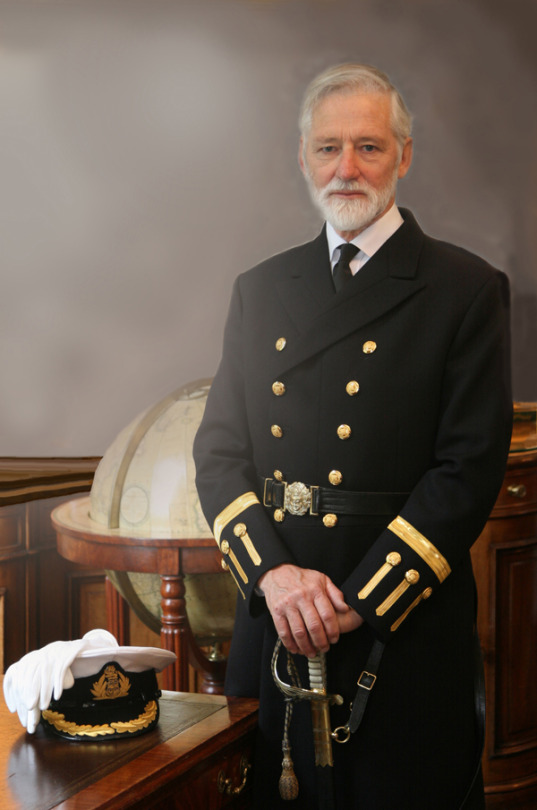
Richard Woodman
Writer who drew on his own experience at sea in a series of novels and historical works about the British merchant navy
“The end was anticlimax. We slipped home unnoticed. Britain turned no hair at our arrival, as just as she has turned no hair at our extinction.” When Richard Woodman published Voyage East in 1988, he knew that the mercantile world depicted within it, which he had joined aged 16, was gone.
The first-person novel – which never reads like fiction – describes the voyage of a cargo liner carrying goods and passengers from Liverpool to Singapore, Hong Kong, Kobe and Shanghai in the mid-1960s. There is a moment, off the coast of Borneo, when the captain sees a vessel with half a dozen grey aluminium boxes on her foredeck: “What the devil are they?” he asks the pilot. “‘They’re containers, Captain,’ the Pilot replied, and no one on the bridge heard the sentence of death pronounced upon us.”
Woodman, who has died aged 80, became the memorialist of the merchant fleets. Between 2008 and 2016 he wrote the history of the British merchant navy in five volumes, followed by A Low Set of Blackguards, a two-volume history (2016-17) of the East India Company.
His outstanding contribution came through his three second world war convoy histories: Arctic Convoys (1994), Malta Convoys (2000) and The Real Cruel Sea (2005). These are works of passion, based on experience and scrupulous research.
The loss of life among merchant seamen was proportionately greater than in any of the armed services and the recognition they received far less. From the beginning of the war a seafarer’s pay was stopped the minute his ship was sunk. “Time spent fighting for his life on a float or lifeboat was an unpaid excursion,” wrote Woodman.
While Winston Churchill acknowledged the crucial importance of the Battle of the Atlantic to national survival, it was not until 2012 that those who had served in the Arctic convoys, and had taken the highest casualties of all, were retrospectively honoured.
Born in north London, Richard was the elder son of Rosalie (nee Cann) and Douglas Woodman, a civil service administrator. Though he was far from the sea, his imagination was captured by the works of Arthur Ransome, Daniel Defoe, RM Ballantyne and Alan Villiers, and his enthusiasm nurtured by Sea Scout membership.
He was the youngest member of the Sea Scout crew that sailed the ex-German yawl Nordwind in the 1960 Tall Ships race and, despite failing all but two of his O-levels, he was accepted as an indentured apprentice with the Alfred Holt (Blue Funnel) line in 1960.
His first long trip to Australia came as a midshipman on the SS Glenarty, returning via the US: “I had been round the world before I would have been allowed inside a British pub.” Life on board ship took place in an uncompromising, all-male environment: the almost compulsory swearing, drinking and sexist banter encouraged the development of “a carapace behind which we hid our private selves”.
Woodman responded eagerly to the hands-on education in seamanship and navigation, developed his writing and sketching through the log-keeping and read his way through the excellent ships’ libraries provided by the Marine Society. He completed his four-year apprenticeship and gained his second mate’s certificate. He was, however, in love and hated saying goodbye to his girlfriend, Christine Hite, an art student, for many months at a time.
He left Blue Funnel in the mid-1960s and went to work for the Ocean Weather Service, where he discovered how vicious the North Atlantic winter weather systems could be – and how pitilessly an ex-second world war corvette would roll. Fortunately it was not long before a temporary position became available with Trinity House, the corporation charged with the maintenance of navigation marks around England, Wales and the Channel Islands.
The position became permanent; he and Christine married in 1969 and settled in Harwich, Essex, near the Trinity House east coast depot, and he served the corporation for most of the rest of his life.
The work at sea was varied, challenging, sometimes dangerous. Precise navigation, seamanship and attention to detail were essential qualities, but Woodman also found time to write. His first novel, The Eye of the Fleet, was published in 1981. This introduced a series of 14 adventures featuring the young Nathaniel Drinkwater, a hero somewhat in the Horatio Hornblower mode but bearing the unmistakable stamp of a writer who was also a sailor.
Despite his professional career being in motorised vessels, Woodman loved traditional gaff-rigged yachts, particularly his own Kestrel and then Andromeda, in which he and Christine explored the east coast rivers and beyond. The action of his nautical novels often turns on neat, seamanlike manoeuvres as well as including varied and closely observed seascapes.
His productivity was astonishing. He often wrote two or three novels a year and soon added non-fiction to his output. When he became captain of Trinity House Vessel Patricia, he achieved this by having two desks, one from which he could conduct official business, the other hidden behind a door, with a page from the work in progress always ready in the typewriter.
Meanwhile, in his job he was extremely focused, conscientious and painstaking. Although some remember him as being of the “old school”, Jill Kernick, the first woman in almost 500 years to work at sea for Trinity House, credits him with helping her break through traditional barriers in the early 80s.
In 1997 Woodman retired to write full time, but was soon elected a Younger Brother of Trinity House, and then an Elder Brother, the first time a former employee was accorded this honour. He was diagnosed with cancer in 2003 but there was no let-up in his work rate. His last completed novel, A River in Borneo (2022), harks back to 60s Indonesia but sets its final scene in a Colchester hospice.
He is survived by Christine and their children, Abigail and Edward, and grandson, Arlo.
🔔 Richard Martin Woodman, master mariner and author, born 10 March 1944; died 2 October 2024
Daily inspiration. Discover more photos at Just for Books…?
26 notes
·
View notes
Note
I didn't know you wanted to visit the US! Any specific place you want to see?
I want to travel as much as possible! Currently, I'm only able to visit places where my friend's live because I can't afford flying tickets + hotel expenses. But I keep my fingers crossed that future will be more abundant!
I've been invited to visit California near Los Angeles but as always, you need a car to go around there so I couldn't go. I don't have a driver's license.
I've also been invited to Boston but I haven't gone yet. I'd like to visit Salem while I'm there, the witch craze history nerd that I am. Boston is possible as the place of accommodation is in the city and I can use city's transport system.
My friend was in New York for a work trip and said that it was a very nice, friendly place. She's been traveling a lot and also lived abroad like in Spain, Japan and India, so I trust her experiences.
Otherwise, I have no wishes. USA is so gigantic that to see everything, I think I'd need to visit a big city AND a small place in all directions; north, north-east, east, south-east, south, south-west, west and north-west.
17 notes
·
View notes
Text

Portrait of an Indian Lady, traditionally called the Bibi of John Wombwell (d. 1795), Arthur William Devis
In Calcutta [Arthur William Devis] quickly established himself as one of the leading European painters in India, painting portraits of a number of the most eminent figures among the British community, including Warren Hastings, the Governor-General. [...]
More so than most European artists working in India, however, with the possible exception of Renaldi, Devis’s work in India demonstrates a clear interest in the native population of the Subcontinent – a sensibility that some historians have credited to his experiences in the Pellew Islands. Whilst principally based in Calcutta, he made frequent trips out into the surrounding country to sketch Indian villagers at work. In the autumn of 1786 he travelled as far as Patna, on the south bank of the Ganges in the north eastern state of Bihar. There he made studies of local people engaged in their traditional industries, including paper and saltpetre making, as well as the weaving of stripped cotton carpets, known as satringis, for which Patna was famous. It may be to this trip that the present portrait relates, particularly with the richly stripped textiles of the lady’s divan and the notable cusped archway in the background, typical of India’s northern cities. [...]
Reclining on a richly cushioned divan, wearing a saffron coloured sari and sumptuous jewels, the unknown Indian lady depicted in this portrait is clearly somebody of noble birth and high social status. At her side is a gilt stemmed cup overflowing with jewels, while a bihishti lays the dust in the courtyard beyond. It is a scene of opulent leisure and casual refinery. The composition closely relates to a portrait of Anne Heatly, probably the bibi of Suetonius Grant Heatly, an American born East India Company official who held positions at Chotanagpur, Palamu and Purina. Both paintings share the same compositional elements, including the red bolster and cushions with their green and yellow stripped bordering; the tazza like cup with its hanging pearls; the archway and the background figures; whilst the sitter’s themselves share the same heavy-lidded eyes; soft, flowing drapery and elegantly reclining pose. The portrait of Anne Heatly, which appeared at auction in 2006, was also previously given to Charles Smith. However, following subsequent cleaning and restoration, it has also now been correctly identified as being by Devis. The two paintings, almost mirror images of each other, save for the difference in format (the portrait of Heatly being in landscape), clearly belong to the same moment in the artist’s career.
Whilst the sitter in the present portrait remains unknown, as Mildred Archer noted, she is too confident in her poise to be an orthodox Muslim woman of rank – who would not have allowed herself to be painted in public – and is most likely the bibi of another high-ranking British official. The term bibi has its roots in the Indian word for ‘princess’ and served as a personalised or intimate reference to the women who first formed relationships with European traders in the seventieth century who were, in fact, mostly princesses of Indian royal families. Young women taken from the royal zenana – sisters, nieces, daughters of the ruling nawab or his brothers – and given in arranged marriages to important European officials, they played an important role in strengthening the diplomatic alliances between a reigning nawab and powerful Company representatives that promoted the political and economic interests of both parties (much in the same way that European royal courts use arranged marriage as a means of strengthening diplomatic ties). Well educated at home by elderly scholars, these noblewomen were literate, often able to speak and read several languages and regional dialects, and schooled in the study of mathematics, history, the natural sciences and medicine. In many cases these marriages produced genuinely happy unions, with the multi-racial offspring they produced further helping to knit the Indian and European communities together.
The custom of high-ranking British Company officials taking an aristocratic Indian mistress continued as both a social and political necessity well into the eighteenth century, to which a number of known portraits of the mistresses of British officials by the likes of Zoffany, Renaldi and James Wales attest. The practice was finally ended by the Marquess Wellesley when he was Governor-General in the 1790s, following which the British and Indian communities became increasing segregated through the course of the nineteenth century.
[Text from Sotheby's]
3 notes
·
View notes
Note
Have you ever been to North East of India? It's very pretty
I've been there once when I was Kid. And I remember the mountain views so so vividly (I was enchanted), even though I've forgotten everything else. I'm planning my next Trip there😭 I've been dying to explore North East! The people, the culture, the aesthetics, it's all soo beautiful! Just watching the pictures makes my heart happy🧡
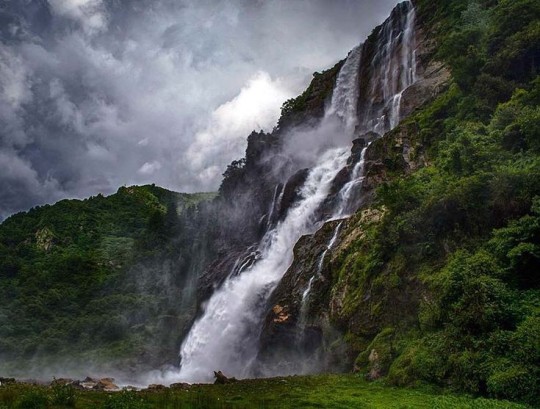

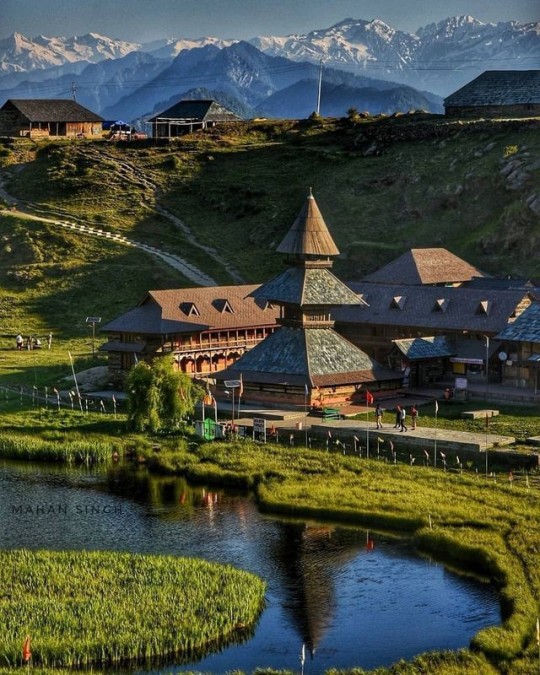

I've had these pictures in my Pinterest board for long and I'm very veryyy excited to visit! I might dig myself a hole in middle of a forest and stay there for eons😭😭 I'm not even kidding, I've waited so long to come there. This year, its finally happening. So yayyy 🗻❤
10 notes
·
View notes
Text

6 Dark Places Aleister Crowley Performed His Particular Brand of Magick
Born in the late 1870s, England, Aleister Crowley was one of the great characters of the 20th century—a poet, a magician, a journalist, an alchemist, a philosopher, a spy, a self-affirmed drug fiend, and a sex addict. He was also known as “The Great Beast” and the “wickedest man in the world.” He played a major role in the creation of alternate religions like Wicca, the A∴A∴, and the Ordo Templi Orientis, and he founded the Order of Thelema, a semi-Satanic cult whose famous edict was “do what thou wilt.”
Crowley is to the occult as Tolkien is to fantasy—he set the stage that everyone else plays in. Basically, if you’re dabbling in things dark and dastardly, Aleister was probably there first.
In all of his doings, Crowley traveled a lot. He pursued exploits in Egypt, India, the Far East, Australia, all over Europe and North America, dotting the map with sex magick and weird stunts. Here are a six places in the Atlas where the infamous occultist left his mark.
1. 36 Blythe Road
LONDON, ENGLAND
Though he was interested in the occult from childhood, Crowley’s first foray into organized magic (or “magick,” as he preferred to spell it) was with the Hermetic Order of the Golden Dawn. Well liked by its co-founder, Samuel Liddell MacGregor Mathers, Crowley advanced in the ranks very quickly. However, not everyone was a fan. The London chapter, which had already found faults in Mathers’ leadership, particularly disavowed him for the eccentric, bisexual Crowley. This caused a decisive rift between two factions of the Order, but Mathers wasn’t ready to concede his leadership.
In 1900, while the poet and London chapter leader W. B. Yeats was heading a meeting, he was attacked by an “astral siege” from none other than Aleister Crowley. Crowley, wearing a black Osiris mask and a kilt, and his mistress burst into the temple, casting spells and brandishing daggers. They intended to take the temple for Mathers’, but were unsuccessful. The police came, the scuffle went to court, and the London chapter of the Golden Dawn won (as they paid the rent on the space). Now the nondescript George’s Cafe resides in the former site of the secret society’s temple, with no indication of its former life.
2. Boleskine House
INVERNESS, SCOTLAND
Boleskine House was steeped in darkness long before Crowley moved in. The manor is allegedly built atop the ruins of a 10th century church that burnt to the ground during a service, killing all the congregants inside. Crowley bought Boleskine House to seclude himself and perform magic from The Book of Sacred Magic of Abramelin the Mage. It was during this period that Crowley became famous for his occultism and black magic, both around the Scotland and later, the world. Sometime during this period Mathers called Crowley to Paris. He left without dispelling the “12 Kings and Dukes of Hell” he had summoned, and many locals blame the house’s unlucky history on evil spirits left behind.
First, Crowley’s housekeeper’s two children died mysteriously and abruptly. Crowley also bragged that one employee of the estate who had long abstained from alcohol got drunk and attempted to murder his entire family. After the house had changed hands, it still wasn’t free of dark energy. In 1965, the army major who owned the house committed suicide by shotgun. The next owner, Led Zeppelin’s Jimmy Page, spent very little time at the estate, instead bequeathing it to a friend who didn’t mind the unexplained creaks, groans, and various ghostly apparitions, but was bothered by the Crowley and Page fans who frequently attempted to break into the house and defile the grounds. Later owners dismissed any notions of hauntings or witchcraft at the house, but in 2015, the residents returned from a shopping trip to find the house completely in flames.
3. Crowley’s Magickal Retirement
HEBRON, NEW HAMPSHIRE
In 1916, Crowley spent four months at the home of renowned medium Evangeline Adams in what he called a “magickal retirement.” This didn’t mean taking a break from cocaine, heroin, sex magick, and prolonged rituals. Quite the opposite in fact. In Hebron, Crowley doubled down and did a great deal of writing, poetry and magical instruction alike. He was even a ghost writer on several of Adams’ books of astrology.
4. Esopus Island
HYDE PARK, NEW YORK
In another magickal retreat, Crowley spent 40 days and 40 nights (a la Jesus Christ) on a tiny island in the Hudson River. His mission was translating the Tao Te Ching, a 4th century Chinese philosophical text. He hadn’t brought much food but had packed plenty of red paint, and also put himself to work painting Thelemic graffiti on the island’s rocks. Curious families watching the bald, robed man on the island from the banks of the Hudson began bringing him rations. He was also visited by fans and artists, who brought him food, drugs, and company.
Much later Crowley reported experiencing visions of his past lives during his stay on Esopus Island, all of which were somehow very influential figures. His former selves included legendary Taoist Ge Xuan, Renaissance Pope Alexander VI, alchemist Alessandro Cagliostro, and the magician Eliphas Levi. Today, the island is open to the public so long as they can reach it by boat. There are even camping amenities for those who wish to follow in the footsteps of the infamous occultist.
5. Boca do Inferno
CASCAIS, PORTUGAL
Any eccentric worth his salt has to fake his own death at least once. When visiting Portugal in 1930 and feeling annoyed by his current mistress, Crowley gave appearance he had committed suicide at the Boca de Inferno (“Mouth of Hell”) caves. His friend, poet Fernando Pessoa handed Crowley’s suicide note to newspapers, helpfully explaining the magical symbols and translating the mangled Portuguese to police and media alike. Three weeks later, Crowley reappeared at the opening of an exhibition of his works in a Berlin gallery, suggesting this whole affair was more publicity stunt than anything else. Today, there is a small white plaque mounted on the rock provides the text of Crowley’s note: “Não Posso Viver Sem Ti. A outra ‘Boca De Infierno’ apanhar-me-á não será tão quente como a tua,” which translates roughly to “Can’t live without you. The other mouth of hell that will catch me won’t be as hot as yours.” That might be touching if any of it were genuine.
6. The Abbey of Thelema
CEFALÙ, ITALY
Crowley’s magickal career came to its peak in a little Sicilian town. For a small amount of money, he, his two lovers, their small children, and miscellaneous followers moved into one story house facing the Mediterranean sea. They called it the Abbey of Thelema. The common room was dedicated to ritual practices and held a scarlet “magick” circle marked with the sign of the major Thelemic deities. Crowley’s own bedroom, labeled by himself as “la chambre des cauchemars” (or “the room of nightmares”) was entirely hand-painted by the occultist with explicitly erotic frescos, hermaphroditic goblins, and vividly colored monsters. This private room was used for specific night initiations involving psychoactive drugs which gave terrifying cinematic life to this Bosch-like vision of hellish debauchery.
Crowley considered his temple a school of magick, and gave it an appropriately collegiate motto: “Collegium ad Spiritum Sanctum”—”A College towards the Holy Spirit.” The Cefalù period was one of the most prolific and happy of his life, even as he suffered from drug addiction and had to write the scandalous Diary of a Drug Fiend to finance his community. The growing interest in dark magic and the occult provided him with an ample student body (pun intended). But in 1922, the experience in monasticism ended when Raoul Loveday, a young disciple, tragically died from typhoid fever contracted from drinking contaminated spring water, though Loveday’s wife maintained it was from drinking cat’s blood.
Crowley and his people were evicted by Mussolini’s regime in 1923. The dictator had no sympathy for pornographic art or mysticism. Once the Abbey closed, the villagers whitewashed the murals, which they somewhat correctly saw as demonic. This erased much of the history and work of Crowley in Cefalù. The Abbey of Thelema is still there, a hidden monument of mysterious, magickal decay.
#6 Dark Places Aleister Crowley Performed His Particular Brand of Magick#aliester crowley#ghost and hauntings#paranormal#ghost and spirits#haunted locations#myhauntedsalem#haunted salem
16 notes
·
View notes
Text
Meghalaya Tourism: An Ideal Travel Guide

Meghalaya, meaning "the abode of clouds", is a paradise for nature lovers. This hill station in Northeast India has captivated travelers worldwide with its truly magnificent and enchanting skies. Nestled in the Himalayas, Meghalaya shares its borders with Bangladesh to the east and south and Assam to the north.
Unforgettable Experiences Await
Meghalaya boasts a plethora of tourist attractions, from towering hills and valleys to countless lakes, cascading waterfalls, pitch-black caves, and sacred forests. Panoramic views, misty hills, terraced slopes, flowing waterfalls, and serpentine rivers are sure to enthrall your soul.
Meghalaya will awaken all your senses. From cultural highlights to heart-pounding adventures, numerous unforgettable encounters await the curious traveler.
Cultural Tapestry
Meghalaya's cultural tapestry is woven with numerous threads. The vibrant traditional festivals are a fantastic way to experience the uniqueness of the state's indigenous population. Soak in the customs of the locals and the breathtaking views while learning about the message each festival conveys. Explore some of the state's local history while sampling the various cuisines it has to offer. Get lost in the area's markets and take advantage of the burgeoning nightlife scene. Meghalaya is renowned for its contemporary cultural celebrations that honor local and international artistic talent. Expect a showcase of music, art, intriguing cultural customs, and more.
Top Tourist Destinations
Popular tourist spots in Meghalaya include Shillong, Tura, Jowai, Cherrapunjee, Nongpoh, and Baghmara. There are numerous tourist attractions in Meghalaya that are worth a visit, including:
Shillong (Scotland of the East): Explore Shillong Peak, Elephant Falls, Ward's Lake, Don Bosco Museum, and Umiam Lake.
Cherrapunjee (One of the wettest places on Earth): Witness the awe-inspiring Dain-Thlen, Kynrem, Nohkalikai waterfalls, and the marvel of engineering - Double Decker Living Root Bridge. Explore Mawsmai Cave, Seven Sister Falls, and Wei Sawdong Falls.
Mawsynram (Another contender for the wettest place on Earth): Visit the famed Jakrem Hot Spring and the Mawjymbuin Cave.
Mawlynnong (Asia's Cleanest Village): Experience serenity amidst spotless surroundings and explore the Living Root Bridge and Balancing Rock.
Dawki (Crystal-clear Dawki River): Enjoy kayaking, snorkeling, and camping by the river in Shnongpdeng Village. Take in the scenic beauty of the Dawki River and the Indo-Bangladesh Border.
Best Time to Visit:
March to June: Pleasant weather, ideal for sightseeing and adventure activities.
July to September: Perfect for relaxation and enjoying the beauty of the rainy season.
October to November: Witness the vibrant cherry blossoms in autumn.
December to February: Ideal for hiking excursions and exploring nearby locations.
How to Reach Meghalaya:
By Train: The nearest train station is Guwahati (Assam), 180 kilometers away. Taxis or buses can take you to Meghalaya from Guwahati.
By Air: Lokpriya Gopinath Bordoloi International Airport in Guwahati (Assam) is the nearest major airport. Taxis can take you to Meghalaya from the airport.
By Road: Major cities are well-connected to Meghalaya by roadways.
Travel Tips:
Research local permits required for specific activities.
Book your accommodations in advance, especially during peak season.
Pack essentials like rain gear and comfortable shoes.
Plan your itinerary based on your interests and time constraints.
Budget for your trip, including transportation, accommodation, food, and activities.
Sample the local cuisine - a delightful way to experience the culture.
Respect local customs and traditions.
Rainfall in Meghalaya:
Meghalaya receives an average annual rainfall of 1,150 millimeters. The state lives up to its name, with the sky rarely remaining cloud-free.
Weather in Meghalaya:
Meghalaya boasts pleasant weather year-round with an average temperature of 24°C. The monsoon season brings ample rainfall, enhancing the beauty of the natural landscape. Winters are dry with moderate temperatures.
Ready to Explore?
Meghalaya, with its stunning beauty, rich culture, and diverse experiences, is a destination that will leave you mesmerized. Let Kajaawa Tours & Cabs craft your dream Meghalaya adventure and help you discover the hidden gems of this incredible state!
2 notes
·
View notes
Text
Hamas is not the Palestinian people. Hamas is a terrorist organization that came to power in Gaza in 2006.
For the Christian
youtube
Johnnie Moore's International religious liberty bio from Wikipedia:
China:
Moore condemned China’s treatment of Muslims in 2017 and wrote an open letter to the Chinese premier alongside of Rabbi Abraham Cooper from the Simon Wiesenthal Center.[8] In May 2021, the People's Republic of China issued retaliatory sanctions against Moore that banned him from entering the territory that it controls the United States issued sanctions against a Chinese official for the official's involvement in the detention of Falun Gong pratcitioners.[9][10][11]
Middle East:
In 2017 Moore joined the Los Angeles Museum of Tolerance Press Conference calling for tolerance and the end of bigotry.[12][13] Moore played a key role in the release of the historic Bahrain Declaration calling for rights for religious minorities in the Middle East. Days after the move of the Jerusalem embassy more led a multi-faith peace delegation from the Kingdom of Bahrain on a pilgrimage in Jerusalem.[13] Moore’s Bahraini trip to Jerusalem prompted his being listed on the electronic intifada for allegedly forging and alliance between Bahrain and Israel in defiance of the Arab boycotts of Israel.[14][15]
Moore met and raised awareness of human rights issues with the Saudi CP within weeks of the death of Khashoggi.[16] He also visited the country on 9/11 and is an advocate of the Crown Prince’s Vision 2030 reform agenda.[17] Moore participated in the announcement of the first ever Chief Rabbi for the United Arab Emirates[18] and held meetings with heads of state throughout the Islamic world with the Crown Prince of the United Arab Emirates in 2018[19] as well as advocating for persecuted Hindus in India.[20] He now serves on the ADL Task Force for Protecting Minority Groups in the Middle East.[21]
Moore praised the Kingdom of Jordan for its interfaith efforts[22] as well as praising the President of Azerbijain as a model of peaceful coexistence.[23] He has also met with Israeli Prime Minister Benjamin Netanyahu and various Palestinian leaders,[24] the President of Azerbaijan,[25][26] and twice with the Crown Prince of the Kingdom of Saudi Arabia in 2019 and 2018[27][28] and he has met with the World Council of Churches.[29]
Moore referred to the ISIS threat against Christians in Iraq and Syria as a “once in a 1000 year threat to Christianity.”[30] He chartered a private jet and organized the evacuation and resettlement of ISIS victims from Northern Iraq to Slovakia over Christmas in 2015, a first in a series of efforts that eventually resettled over 10,000 Christian and Yazidi refugees displaced by ISIS.[31][32] On September 11, 2019 he joined forces with Muhammad Alissa of the Muslim World League to issue a joint statement calling for cooperation between evangelicals like Moore and Muslims with a focus on protecting Christian holy sites.[33] Moore is a critic of Iran and has called for the Iranian people to take back their religion from their supreme leader.[34][35] He praised Pakistan’s prime minister for the arrest of a leading terrorist[20] and in 2019 his advocacy was credited for the release of an 82-year-old Muslim prisoner of conscience in Pakistan, Abdul Shakoor.[36][37]
Moore was among an evangelical delegation who met with Egyptian government officials[38][39] and was the guest of Egypt’s president for the grand opening of the Middle East’s largest cathedral.[40]
North Korea:
Moore was involved in bringing together liberal, moderate and conservative evangelicals in a joint call for prayer for peace in North Korea.
Terrorism Primer
youtube

Peace Process Primer
youtube
youtube
#terrorism#hamas#israel#heartbreaking 💔#evil#pray for the peace of jerusalem#open borders#religious liberty#soros#Youtube
6 notes
·
View notes
Text
issuu
#Singapore Tours Package Including Sentosa Island Tour#Sri Lanka Honeymoon Tour Packages From India#Trip to Uttarakhand#Himachal Honeymoon Tour Packages#North East Tour Packages#Honeymoon Packages of Malaysia#Family Trip to north east#Vaadhoo Island Resort Maldives Tour Packages#Book Vietnam Tour packages From India#Honeymoon tour packages of Shimla and Manali#Vibrant Gujarat Family Tour Packages#Wonderful Singapore Tour Package#Honeymoon Packages of Maldives#Best Bangalore to Bali tour packages#Kerala special holiday Tour Packages#Travel Agency in Uttarakhand#Dubai Tour Packages From India#Malaysia Tour Package#Best Honeymoon Packages for Mauritius#Kerala Tour Packages#Goa Tour Packages From Udaipur Rajasthan#Best Sri Lanka Tour Packages#Travel Agency for Thailand Seaside Tours#Goa Tour Packages#Gujarat Tour Packages#Book Rajasthan Tour Packages#Bali tour packages#Maldives Tour Packages#Singapore Tour Packages From India
1 note
·
View note
Note
whats a clipper ship and why is it better (i assume) than other ships and why is it important to the story. they never made me read moby dick in school so I'm genuinely interested
HELLO HELLO imback on my PUTER so i can type so so fast SO FIRST OF ALL genuinely clipper ships are not important to moby dick at all lmao 💀i just like them cos theyre the fastest sailing ships ever so uhh quick breakdown
clippers are the product of american shipbuilders putting a packet ship-esque build on a larger merchant ship
a packet ship is a sort of ship that was small and fast, used specifically for trips from america's east coast to england, usually liverpool. these fuckers were the fastest ships when they were built, and many many sailors died on their voyages bc the captains tried to make em fast as possible
so. we've got tiny fast ship. we've also got large slow merchant ships used in britian for the china and india trade. we've got a man (donald mckay) who rlly likes building ships and is good at his job. puts a packet-esque build on a large-scale ship
for context: the british ships were referred to as 'kettle-bottoms' cos they had flat bottoms that were built mostly to avoid stupid tonnage laws (that the british put in place) (everybody fuckin hated the tonnage laws) and the clippers had a much more streamlined bottom & a differently shaped rudder. they also carried a fuckton of sail, had 3 mainmasts and around 4 sails on each of those
SO the clipper was built. first used for shit like the china trade in the 1840s, then later on until around 1855-56 used as transportation to california for the gold rush. theyre most commonly recognized for the gold rush stuff cos they had to swing round cape horn every single time & that place is fucked UPP for sailing
so these babygirls are the fastest sailing ships ever built (the most notable one technically being the lightning, she was very VERY fast) (my favourite being the sea witch, from when the clippers were still kinda in Prototype Mode)
so yeah these speedy fucks kind of heralded in the end of the age of sail. they were built, had their beautiful and sexy and fleeting run, and then everything turned to motTHER FUCKING STEAM SHIPS FUCK FUCK PISS SHIT
and uhhh that is most of it LMAO but the ships used in the whaling industry were. just called whaling ships 💀💀or smth. ive been trying to find more info on them & on whaling but the most ive found is a 100-pg book of whaling anecdotes which are GOOD but dont tell me anything abt the ships they sailed on other than that the people who hunted whales up north were the ones who invented the crows nest!!!!!!!! auaugh!!!!!
& take all this w a grain of salt bc im fully j dragging it from my memory of arther h clarks book on clippers. im onlhy in the beginning stages of reading clippers: greyhounds of the sea (which has MUCH more information!! very pog) so. that is how it is lmao. unironically thank u so much for asking this im having the timeof my life rn :)
#clipper ship#clipper ship tumblr#cmon guys we can make this a thing !!! please#sailing ship#age of sail
10 notes
·
View notes